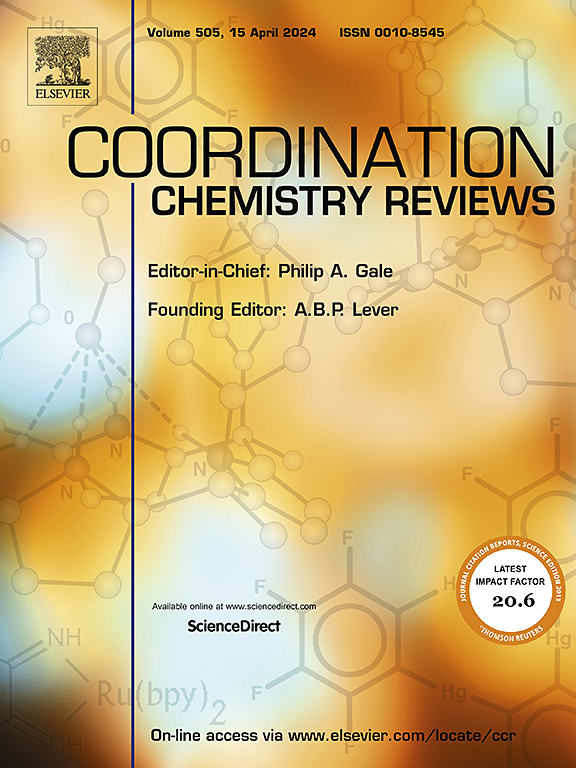Hydrogen production via nanocatalyzed ammonia borane hydrolysis: State of the art, recent progress and perspectives
IF 23.5
1区 化学
Q1 CHEMISTRY, INORGANIC & NUCLEAR
引用次数: 0
Abstract
The production, transport and utilization of hydrogen (H2), a green energy source, are now essential to our modern society in order to face ecological issues involved with fossil fuels that generate CO2 and toxic particles. Therefore, the search of safe H2 carriers that are stable in water and have a high hydrogen atom content is promising. Ammonia borane hydrolysis (ABH) is now considered as a possible candidate process to safely generate H2 upon nanocatalysis. After recalling the historical context and early mechanistic proposals, this review presents the compared efficiencies of various nanomaterials, including a choice of sophisticated supports in room temperature catalysis and photocatalysis of H2 generation upon ABH. Pioneering works in the late 2000s and most remarkable reports from the 2010s are recalled, and the articles from the last three years are reviewed. The turnover frequency (TOF) and activation energy (Ea) of various nanocatalysts are compared, and the mechanisms are discussed, in particular the electronic interactions involved between the metals, heteroatoms and supports are examined in the light of Density Functional Theory (DFT) calculations. The review also includes discussions of the authors' groups results and catalytic proposals on the particularly efficient thermal and photolytic ABH reactions catalyzed by metal and alloy nanocatalysts embedded in the zeolitic imidazolate framework (ZIF)-8. As a complement, the main catalyst performances (TOF and Ea) during the last five years are summarized in tables. In conclusion, the main progress in H2 generation from ABH is summarized in this review, and perspectives are provided concerning the possible utilization of H2 generated from catalyzed ABH as portable H2 storage devices. Recent progress in ABH has shown that, with the best catalyst designs, H2 is release at RT within a few seconds at room temperature (TOFs of several thousands molH2 molcat−1 min−1), which is far superior for H2 storage to physisorption that requires large material amounts or other chemisorption materials such as Mg, since high temperatures such as 300 °C are necessary for H2 release from MgH2. Much work involving AB recycling is still necessary in the near future, however, in order to commercially extend ABH to Hydrogen Fuel Cell powering.


纳米催化氨硼烷水解制氢:现状、最新进展和展望
氢(H2)是一种绿色能源,它的生产、运输和利用对于我们的现代社会来说是必不可少的,因为化石燃料会产生二氧化碳和有毒颗粒。因此,寻找在水中稳定且具有高氢原子含量的安全H2载体是有前景的。氨硼烷水解(ABH)现在被认为是一种可能的候选工艺,可以在纳米催化下安全生成氢气。在回顾了历史背景和早期的机制建议之后,本文介绍了各种纳米材料的效率比较,包括在室温催化和光催化下ABH生成H2的复杂载体的选择。回顾2000年代末的先锋作品和2010年代最引人注目的报道,回顾近三年的文章。比较了各种纳米催化剂的转换频率(TOF)和活化能(Ea),讨论了其机理,特别是根据密度泛函理论(DFT)计算分析了金属、杂原子和载体之间的电子相互作用。本文还讨论了作者小组的研究结果,以及在沸石咪唑盐框架(ZIF)-8中嵌入金属和合金纳米催化剂催化的特别有效的热和光解ABH反应的催化建议。作为补充,最近五年的主要催化剂性能(TOF和Ea)在表格中进行了总结。最后,综述了ABH制氢的主要研究进展,并对ABH催化制氢作为便携式储氢装置的应用前景进行了展望。ABH的最新进展表明,在最好的催化剂设计下,H2在室温下几秒钟内就能在RT下释放(tof为数千molH2 molcat−1 min−1),这对于H2的储存来说远远优于需要大量材料或其他化学吸附材料(如Mg)的物理吸附,因为MgH2释放H2需要300 °C这样的高温。然而,在不久的将来,为了将ABH商业化地扩展到氢燃料电池供电,涉及AB回收的大量工作仍然是必要的。
本文章由计算机程序翻译,如有差异,请以英文原文为准。
求助全文
约1分钟内获得全文
求助全文
来源期刊

Coordination Chemistry Reviews
化学-无机化学与核化学
CiteScore
34.30
自引率
5.30%
发文量
457
审稿时长
54 days
期刊介绍:
Coordination Chemistry Reviews offers rapid publication of review articles on current and significant topics in coordination chemistry, encompassing organometallic, supramolecular, theoretical, and bioinorganic chemistry. It also covers catalysis, materials chemistry, and metal-organic frameworks from a coordination chemistry perspective. Reviews summarize recent developments or discuss specific techniques, welcoming contributions from both established and emerging researchers.
The journal releases special issues on timely subjects, including those featuring contributions from specific regions or conferences. Occasional full-length book articles are also featured. Additionally, special volumes cover annual reviews of main group chemistry, transition metal group chemistry, and organometallic chemistry. These comprehensive reviews are vital resources for those engaged in coordination chemistry, further establishing Coordination Chemistry Reviews as a hub for insightful surveys in inorganic and physical inorganic chemistry.
 求助内容:
求助内容: 应助结果提醒方式:
应助结果提醒方式:


